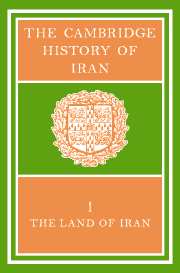Book contents
- Frontmatter
- PART 1 THE LAND
- 1 PHYSICAL GEOGRAPHY
- 2 GEOLOGY
- 3 GEOMORPHOLOGY
- 4 THE ORIGIN OF THE ZAGROS DEFILES
- 5 CLIMATE
- 6 SOILS
- 7 HYDROGRAPHY
- 8 VEGETATION
- 9 MAMMALS
- 10 ZOOGEOGRAPHIC ANALYSIS OF THE LIZARD FAUNA OF IRAN
- 11 ORNITHOLOGY
- PART 2 THE PEOPLE
- PART 3 ECONOMIC LIFE
- PART 4 CONCLUSION
- Bibliography
- Conversion Tables
- Fig. I. Iran: physiographical.
- Plate Section
- Fig 85. Soil potentiality map of Iran.
6 - SOILS
from PART 1 - THE LAND
Published online by Cambridge University Press: 28 March 2008
- Frontmatter
- PART 1 THE LAND
- 1 PHYSICAL GEOGRAPHY
- 2 GEOLOGY
- 3 GEOMORPHOLOGY
- 4 THE ORIGIN OF THE ZAGROS DEFILES
- 5 CLIMATE
- 6 SOILS
- 7 HYDROGRAPHY
- 8 VEGETATION
- 9 MAMMALS
- 10 ZOOGEOGRAPHIC ANALYSIS OF THE LIZARD FAUNA OF IRAN
- 11 ORNITHOLOGY
- PART 2 THE PEOPLE
- PART 3 ECONOMIC LIFE
- PART 4 CONCLUSION
- Bibliography
- Conversion Tables
- Fig. I. Iran: physiographical.
- Plate Section
- Fig 85. Soil potentiality map of Iran.
Summary
Iran is covered to a large extent by the mountains which surround the saline, sandy, and rocky deserts of the central plateau, thus making the plateau a closed basin. Over 50 per cent of the total land surface is mountainous and highly broken in topography. There could be said to be four main physiographic areas in Iran, each with a distinctive character. These are:
The great Zagros and Alburz mountain ranges, which together form a great V-shape;
The area within the V, which begins as a high plateau with its own secondary ranges, and gradually levels towards the interior deserts;
The low-lying plain of Khūzistān, which is a continuation of the Mesopotamian plain; and
The Caspian coast, which lies below the sea-level and forms a separate climatic zone.
The major part of the country is arid or semi-arid; rainfall is restricted to the winter months, and is small in amount everywhere but on the northern flanks of the Alburz mountains, where it varies from 40 to 80 in. annually. On the plateau the average annual rainfall of over 8 in. in the north decreases to less than 5 in. in the south and south-east. At the head of the Persian Gulf the amount is somewhat greater. Snow is common in the high areas above 4,000 ft.
Vegetation varies according to climate. The climax-vegetation consists of oak and beech in the more humid sections of the north (of these trees a considerable number still remain), and a thin cover of grasses and/or scattered shrubs in the semi-arid and arid interior.
- Type
- Chapter
- Information
- The Cambridge History of Iran , pp. 250 - 263Publisher: Cambridge University PressPrint publication year: 1968
- 1
- Cited by

